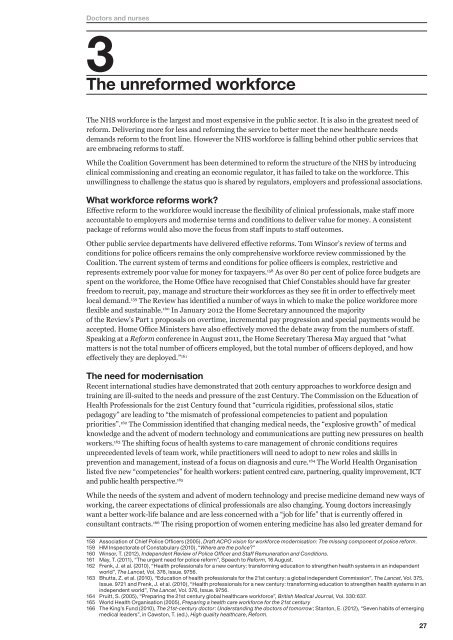Doctors and nurses - Reform
Doctors and nurses - Reform
Doctors and nurses - Reform
Create successful ePaper yourself
Turn your PDF publications into a flip-book with our unique Google optimized e-Paper software.
<strong>Doctors</strong> <strong>and</strong> <strong>nurses</strong><br />
3The unreformed workforce<br />
The NHS workforce is the largest <strong>and</strong> most expensive in the public sector. It is also in the greatest need of<br />
reform. Delivering more for less <strong>and</strong> reforming the service to better meet the new healthcare needs<br />
dem<strong>and</strong>s reform to the front line. However the NHS workforce is falling behind other public services that<br />
are embracing reforms to staff.<br />
While the Coalition Government has been determined to reform the structure of the NHS by introducing<br />
clinical commissioning <strong>and</strong> creating an economic regulator, it has failed to take on the workforce. This<br />
unwillingness to challenge the status quo is shared by regulators, employers <strong>and</strong> professional associations.<br />
What workforce reforms work?<br />
Effective reform to the workforce would increase the flexibility of clinical professionals, make staff more<br />
accountable to employers <strong>and</strong> modernise terms <strong>and</strong> conditions to deliver value for money. A consistent<br />
package of reforms would also move the focus from staff inputs to staff outcomes.<br />
Other public service departments have delivered effective reforms. Tom Winsor’s review of terms <strong>and</strong><br />
conditions for police officers remains the only comprehensive workforce review commissioned by the<br />
Coalition. The current system of terms <strong>and</strong> conditions for police officers is complex, restrictive <strong>and</strong><br />
represents extremely poor value for money for taxpayers. 158 As over 80 per cent of police force budgets are<br />
spent on the workforce, the Home Office have recognised that Chief Constables should have far greater<br />
freedom to recruit, pay, manage <strong>and</strong> structure their workforces as they see fit in order to effectively meet<br />
local dem<strong>and</strong>. 159 The Review has identified a number of ways in which to make the police workforce more<br />
flexible <strong>and</strong> sustainable. 160 In January 2012 the Home Secretary announced the majority<br />
of the Review’s Part 1 proposals on overtime, incremental pay progression <strong>and</strong> special payments would be<br />
accepted. Home Office Ministers have also effectively moved the debate away from the numbers of staff.<br />
Speaking at a <strong>Reform</strong> conference in August 2011, the Home Secretary Theresa May argued that “what<br />
matters is not the total number of officers employed, but the total number of officers deployed, <strong>and</strong> how<br />
effectively they are deployed.” 161<br />
The need for modernisation<br />
Recent international studies have demonstrated that 20th century approaches to workforce design <strong>and</strong><br />
training are ill-suited to the needs <strong>and</strong> pressure of the 21st Century. The Commission on the Education of<br />
Health Professionals for the 21st Century found that “curricula rigidities, professional silos, static<br />
pedagogy” are leading to “the mismatch of professional competencies to patient <strong>and</strong> population<br />
priorities”. 162 The Commission identified that changing medical needs, the “explosive growth” of medical<br />
knowledge <strong>and</strong> the advent of modern technology <strong>and</strong> communications are putting new pressures on health<br />
workers. 163 The shifting focus of health systems to care management of chronic conditions requires<br />
unprecedented levels of team work, while practitioners will need to adopt to new roles <strong>and</strong> skills in<br />
prevention <strong>and</strong> management, instead of a focus on diagnosis <strong>and</strong> cure. 164 The World Health Organisation<br />
listed five new “competencies” for health workers: patient centred care, partnering, quality improvement, ICT<br />
<strong>and</strong> public health perspective. 165<br />
While the needs of the system <strong>and</strong> advent of modern technology <strong>and</strong> precise medicine dem<strong>and</strong> new ways of<br />
working, the career expectations of clinical professionals are also changing. Young doctors increasingly<br />
want a better work-life balance <strong>and</strong> are less concerned with a “job for life” that is currently offered in<br />
consultant contracts. 166 The rising proportion of women entering medicine has also led greater dem<strong>and</strong> for<br />
158 Association of Chief Police Officers (2005), Draft ACPO vision for workforce modernisation: The missing component of police reform.<br />
159 HM Inspectorate of Constabulary (2010), “Where are the police?”<br />
160 Winsor, T. (2012), Independent Review of Police Officer <strong>and</strong> Staff Remuneration <strong>and</strong> Conditions.<br />
161 May, T. (2011), “The urgent need for police reform”, Speech to <strong>Reform</strong>, 16 August.<br />
162 Frenk, J. et al. (2010), “Health professionals for a new century: transforming education to strengthen health systems in an independent<br />
world”, The Lancet, Vol. 376, Issue. 9756.<br />
163 Bhutta, Z. et al. (2010), “Education of health professionals for the 21st century: a global independent Commission”, The Lancet, Vol. 375,<br />
Issue. 9721 <strong>and</strong> Frenk, J. et al. (2010), “Health professionals for a new century: transforming education to strengthen health systems in an<br />
independent world”, The Lancet, Vol. 376, Issue. 9756.<br />
164 Pruitt, S. (2005), “Preparing the 21st century global healthcare workforce”, British Medical Journal, Vol. 330:637.<br />
165 World Health Organisation (2005), Preparing a health care workforce for the 21st century<br />
166 The King’s Fund (2010), The 21st-century doctor: Underst<strong>and</strong>ing the doctors of tomorrow; Stanton, E. (2012), “Seven habits of emerging<br />
medical leaders”, in Cawston, T. (ed.), High quality healthcare, <strong>Reform</strong>.<br />
27

















